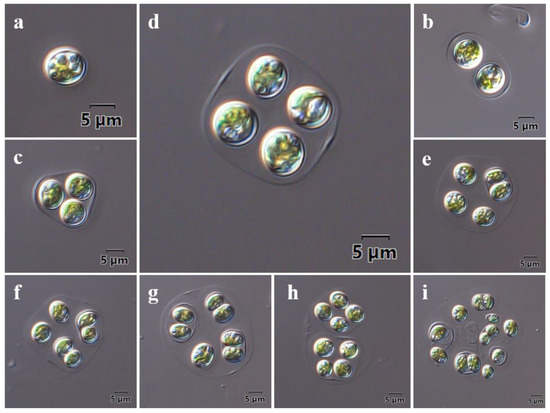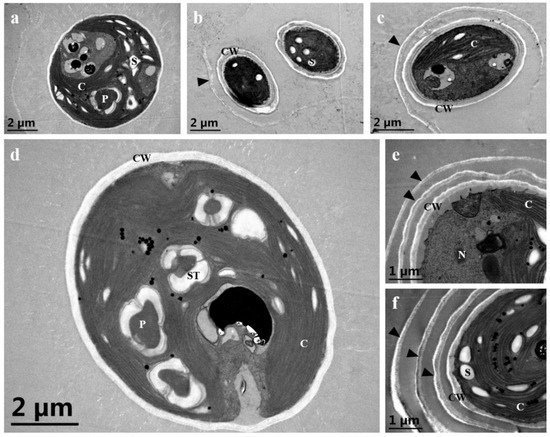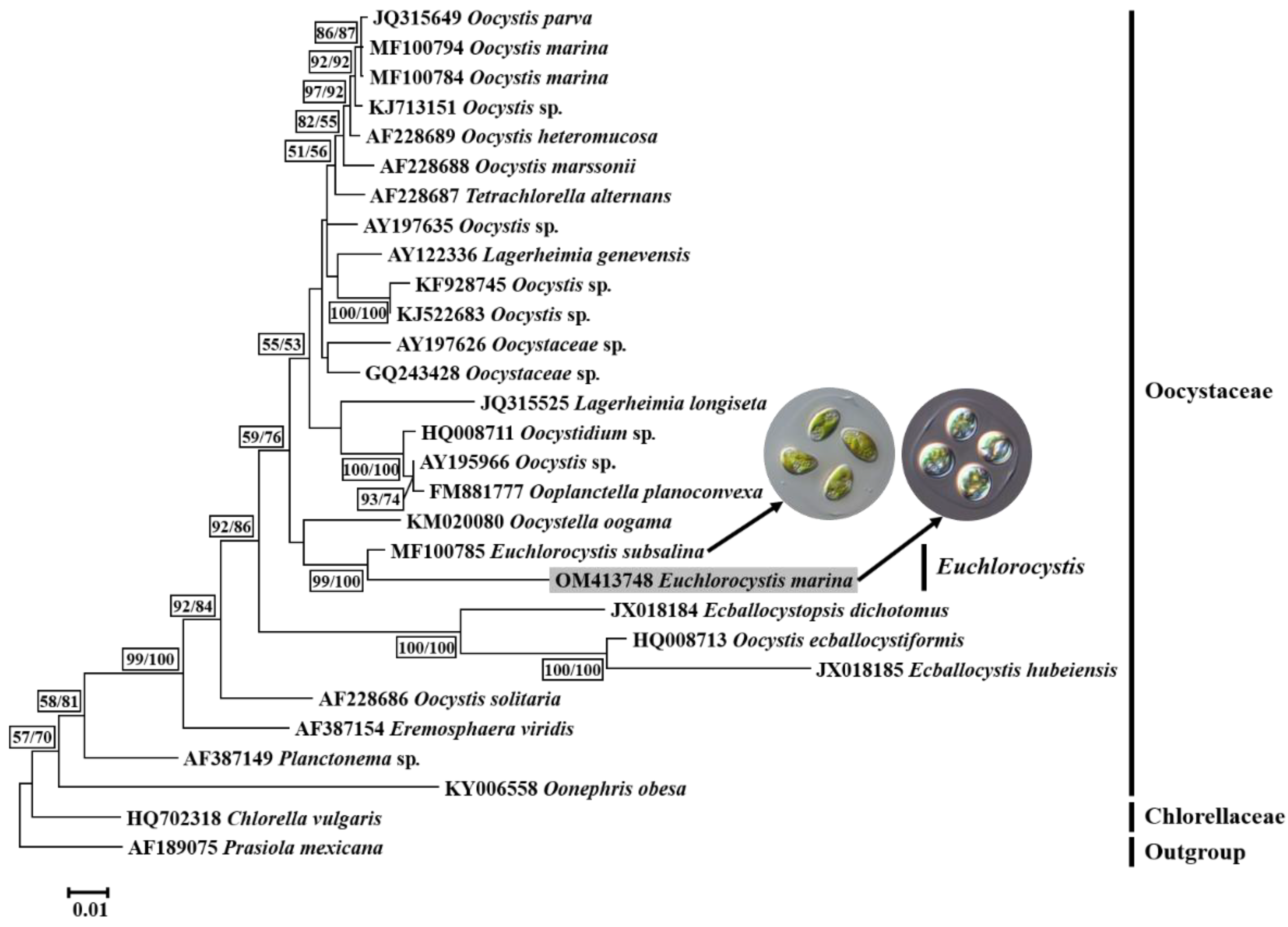You're using an outdated browser. Please upgrade to a modern browser for the best experience.
Please note this is an old version of this entry, which may differ significantly from the current revision.
Subjects:
Limnology
Euchlorocystis marina sp. nov. (oocystaceae, trebouxiophyceae), a new species of green algae from a seawater shrimp culture pond.
- Chorophyta
1. Introduction
Oocystaceae is a cosmopolitan family of green algae with distinct morphology and ultrastructure. It has formed unique and complex biological characteristics and ecological environment adaptability in the course of long-term evolution. Some Oocystaceae species, owing to their high nitrogen and phosphorus removal ability [1][2], high CO2-tolerance [3], simple growth requirements, and adaptability to various environmental conditions [4], have shown great potential in improving the aquaculture water environment [1][4][5], wastewater treatment [2][6], carbon emissions [3], and biofuel [7].
Oocystaceae are widely distributed, with records and reports all over the world. The early morphological classification assigned the Oocystaceae family to the Chlorophyceae class [8][9], but molecular studies confirmed that this family was a monophyletic group in the Trebouxiophyceae class [10][11][12][13]. Štenclová et al. [14] conducted a molecular phylogenetic study on 54 Oocystaceae species in 2017, and divided Oocystaceae into three subfamilies and five clades. Recently, five new genera were defined in the family Oocystaceae, including Planctonemopsis [15], Quadricoccopsis [16], Euchlorocystis, Densicystis [17], and Reticulocystis [18]. Currently, 96 genera and 304 species of Oocystaceae have been recorded in AlgaeBase [19]. However, few marine species of this family have been recorded.
As a new member of the Oocystaceae family, the genus Euchlorocystis was defined by Liu et al. [17] in 2018. The genus Euchlorocystis has multiple pyrenoids, distinguishing it from Oocystis. It also has a multilayered cell wall and trough-shaped chloroplast, which is different from the Oonephris genus. In addition, the cell size of Euchlorocystis and the number of chloroplasts per cell were used as the main morphological markers that distinguish the genus Eremosphaera. Currently, only one taxonomically accepted species of Euchlorocystis is listed in AlgaeBase [19]. A new strain of algae from a mariculture pond of shrimp in Zhanjiang, Guangdong Province, China, and successfully cultured it in the laboratory. Morphological and phylogenetic analyses identified this strain as a new species, Euchlorocystis marina sp. nov., belonging to the Oocystaceae (Trebouxiophyceae, Chlorophyta). The results will increase the understanding of the genus Euchlorocystis and enrich records of marine species of Oocystaceae.
2. Morphological Observations
Cells are solitary or in 2–16 cell colonies within a thin, hyaline mucilaginous envelope or within an expanded mother cell wall (Figure 1). Cells are round, oval, or slightly reniform, ranging in size from 11.3 to 16.6 μm long and 6.3 to 10.3 μm wide. Cell walls are thick, sometimes stratified (Figure 1b,c), and smooth, without thickening polars. Mother cell walls are extended according to the number and arrangement of daughter cells and are usually an irregularly round shape, with or without tapered thickening ends (Figure 1b,d). The number and shape of chloroplasts are difficult to discern on the microscopic level. When observed with TEM, a horseshoe-shaped chloroplast was observed, which occupied most of the cell volume (Figure 2a,d). Asexual reproduction was by 2–4 autospores released by a rupture of the mother cell wall. These autospores could be propagated again independently inside the mother cell (Figure 1e,g). The asynchronous cell division led to the size difference between the daughter cells (Figure 1i) and the formation of multilayer mother cell walls (Figure 2e,f).

Figure 1. Light microscopy of Euchlorocystis marina. (a) Solitary cell; (b) 2-celled colony; (c) 3-celled colony; (d) 4-celled colony; (e) 5-celled colony; (f) 6-celled colony; (g) 7-celled colony; (h) 8-celled colony; (i) 13-celled colony.

Figure 2. Transmission electron microscopy of Euchlorocystis marina sp. nov. (a,d) Mature cells; (b,c) Young cells; (e,f) Ultrastructure of multilayer mother cell wall. (CW = cell wall; C = chloroplast; P = pyrenoid; S = starch grains; ST = starch sheath; N = nucleus). The mother cell walls are indicated by black arrow.
When observed with TEM, 1–4 pyrenoids were observed in the mature cells of Euchlorocystis marina (Figure 2a,d). The pyrenoid was surrounded by a starch sheath composed of 2–4 starch plates, and the pyrenoid matrix was homogenous (Figure 2a,d). However, in some young cells, pyrenoids were not observed (Figure 2b,c).
3. Molecular Phylogeny
Sequencing of the 18S rDNA of the new strain produced a 1720 bp sequence, introns were excluded. The final 18S rDNA sequences alignment of 29 taxa with 1633 base positions were used for the phylogenetic tree construction, and Prasiola mexicana (Prasiolaceae) was chosen for the outgroup. The ML and NJ analyses yielded a similar topology and only the ML tree was presented in Figure 3. The 18S rDNA phylogenetic trees consistently recovered that the newly isolated strain and Euchlorocystis subsalina formed an independent clade with high support (99/100 for ML/NJ) (Figure 3). Direct comparison showed that the 18S rDNA of the new strain had 41 differences (97.5% identity) to Euchlorocystis subsalina (Table 1).

Figure 3. Maximum likelihood tree of 18S rDNA sequences. Bootstrap support from ML and NJ posterior probabilities are presented on the nodes. The sequence obtained in this study is shaded gray. The cell morphology picture of Euchlorocystis subsalina was from Liu et al. [17].
Table 1. Direct comparison of 18S rDNA sequences of Euchlorocystis marina (bold) with some species of the Oocystaceae family. Numbers below the diagonal indicate nucleotide substitutions between a pair of sequences and those above the diagonal are percent identities. Black boxed area indicates the high sequence similarities between the two closest related species.
| Positions Compared: 1633. | Accession Number | Eremo. viridis | Ecball. dichotomus | Oocystis. marina | Euchloro. subsalina | Euchloro. marina | Oocystella. oogama | Oonephris. obesa |
|---|---|---|---|---|---|---|---|---|
| Eremosphaera viridis | AF387154 | — | 90.0% | 94.6% | 94.5% | 92.6% | 93.9% | 87.6% |
| Ecballocystopsis dichotomus | JX018184 | 163 | — | 90.4% | 90.3% | 88.1% | 90.6% | 82.7% |
| Oocystis marina |
MF100784 | 88 | 157 | — | 96.7% | 94.7% | 95.8% | 86.6% |
| Euchlorocystis subsalina | MF100785 | 90 | 158 | 54 | — | 97.5% | 95.8% | 86.8% |
| Euchlorocystis marina | OM413748 | 121 | 194 | 87 | 41 | — | 94.1% | 84.6% |
| Oocystella oogama |
KM020080 | 100 | 154 | 69 | 69 | 96 | — | 86.5% |
| Oonephris obesa |
KY006558 | 202 | 283 | 219 | 216 | 251 | 220 | — |
This entry is adapted from the peer-reviewed paper 10.3390/d14020119
References
- Liu, M.; Huang, X.H.; Zhang, R.; Gu, B.H. Uptake of urea nitrogen by Oocystis borgei in prawn (Litopenaeus vannamei) aquaculture ponds. Bull. Environ. Contam. Toxicol. 2018, 101, 586–591.
- Ajala, S.O.; Alexander, M.L. Assessment of Chlorella vulgaris, Scenedesmus obliquus, and Oocystis minuta for removal of sulfate, nitrate, and phosphate in wastewater. Int. J. Energy Environ. Eng. 2020, 11, 311–326.
- Takeuchi, T.; Utsunomiya, K.; Kobayashi, K.; Owada, M.; Karube, I. Carbon dioxide fixation by a unicellular green alga Oocystis sp. J. Biotechnol. 1992, 25, 261–267.
- Huang, X.H.; Li, C.L.; Liu, C.W.; Zeng, D.S. Study on the ecological factors of Oocystis borgei. J. Zhanjiang Ocean. Univ. 2002, 22, 8–12. (In Chinese)
- Wang, X.Q.; Zhang, Y.L.; Li, C.L.; Huang, X.H.; Li, F.; Wang, X.Y.; Li, G. Allelopathic effect of Oocystis borgei culture on microcystis aeruginosa. Environ. Technol. 2020, 1–10.
- Chuka-ogwude, D.; Ogbonna, J.; Borowitzka, M.A.; Moheimani, N.R. Screening, acclimation and ammonia tolerance of microalgae grown in food waste digestate. J. Appl. Phycol. 2020, 32, 3775–3785.
- Vidyashankar, S.; Venugopal, K.S.; Swarnalatha, G.V.; Kavitha, M.D.; Chauhan, V.S.; Ravi, R.; Bansal, A.K.; Singh, R.; Pande, A.; Ravishankar, G.A.; et al. Characterization of fatty acids and hydrocarbons of Chlorophycean microalgae towards their use as biofuel source. Biomass Bioenergy 2015, 77, 75–91.
- Komárek, J.; Fott, B. Chlorophyceae (Grünalgen) Ordnung: Chlorococcales. In Das Phytoplankton des Süßwassers: Systematik und Biologie; Huber-Pestalozzi, G., Ed.; Schweizerbart’sche Verlagsbuchhandlung: Stuttgart, Germany, 1983; Volume 7, pp. 1–1044.
- Silva, T.G.; Štenclová, L.; Archanjo, N.C.P.; Bagatini, I.L. Revised phylogenetic position of Nephrocytium nägeli (Sphaeropleales, Chlorophyceae), with the description of Nephrocytiaceae fam. nov. and Nephrocytium vieirae sp. nov. Taxon 2021, 70, 917–930.
- Hepperle, D.; Hegewald, E.; Krienitz, L. Phylogenetic position of the Oocystaceae (Chlorophyta). J. Phycol. 2000, 36, 590–595.
- Pažoutová, M.; Škaloud, P.; Nemjová, K. Phylogenetic position of Ooplanctella planoconvexa, gen. et comb. nova and Echinocoleum elegans (Oocystaceae, Trebouxiophyceae, Chlorophyta). Fottea 2010, 10, 75–82.
- Krienitz, L.; Bock, C. Elongatocystis ecballocystiformis gen. et comb. nov., and some reflections on systematics of Oocystaceae (Trebouxiophyceae, Chlorophyta). Fottea 2011, 11, 271–278.
- Xia, S.; Zhu, H.; Cheng, Y.Y.; Liu, G.X.; Hu, Z.Y. Phylogenetic position of Ecballocystis and Ecballocystopsis (Chlorophyta). Fottea 2013, 13, 65–75.
- Štenclová, L.; Fučíková, K.; Kaštovský, J.; Pažoutová, M. Molecular and morphological delimitation and generic classification of the family Oocystaceae (Trebouxiophyceae, Chlorophyta). J. Phycol. 2017, 53, 1263–1282.
- Liu, X.; Zhu, H.; Liu, B.; Liu, G.; Hu, Z. Classification of Planctonema-like algae, including a new genus Planctonemopsis gen. nov., a new species Planctonema gelatinosum sp. nov. and a reinstated genus Psephonema (Trebouxiophyceae, Chlorophyta). J. Phycol. 2017, 53, 869–879.
- Liu, X.; Zhu, H.; Song, H.; Liu, B.; Wang, Q.; Liu, G.; Hu, Z. Quadricoccopsis gen. nov., a new genus of Quadricoccus-like algae in Oocystaceae from China (Trebouxiophyceae, Chlorophyta). Fottea 2018, 18, 189–199.
- Liu, X.; Zhu, H.; Song, H.; Wang, Q.; Xiong, X.; Wu, C.; Liu, G.; Hu, Z. Euchlorocystis gen. nov. and Densicystis gen. nov., two new genera of Oocystaceae algae from high-altitude semi-saline habitat (Trebouxiophyceae, Chlorophyta). J. Eukaryot. Microbiol. 2018, 65, 200–210.
- Liu, X.; Wang, Q.; Zhu, H.; Liu, B.; Rindi, F.; Liu, G.; Xie, S.; Hu, Z. Reticulocystis yunnanense gen. et sp. nov., a new member of freshwater Oocystaceae algae (Trebouxiophyceae, Chlorophyta). Eur. J. Phycol. 2020, 55, 507–516.
- Guiry, M.D.; Guiry, G.M. AlgaeBase. World-Wide Electronic Publication, National University of Ireland, Galway. Available online: https://www.algaebase.org (accessed on 25 October 2021).
This entry is offline, you can click here to edit this entry!
